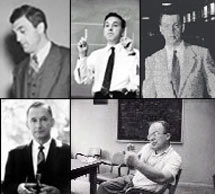
Handy Links
SLAC News Center
SLAC Today
- Subscribe
- Archives: Feb 2006-May 20, 2011
- Archives: May 23, 2011 and later
- Submit Feedback or Story Ideas
- About SLAC Today
SLAC News
Lab News
- Interactions
- Lightsources.org
- ILC NewsLine
- Int'l Science Grid This Week
- Fermilab Today
- Berkeley Lab News
- @brookhaven TODAY
- DOE Pulse
- CERN Courier
- DESY inForm
- US / LHC
SLAC Links
- Emergency
- Safety
- Policy Repository
- Site Entry Form

- Site Maps
- M & O Review
- Computing Status & Calendar
- SLAC Colloquium
- SLACspeak
- SLACspace
- SLAC Logo
- Café Menu
- Flea Market
- Web E-mail
- Marguerite Shuttle
- Discount Commuter Passes
-
Award Reporting Form
- SPIRES
- SciDoc
- Activity Groups
- Library
Stanford
Around the Bay
50-Year Anniversary of "Project M"
 Fifty years ago today, the first official "Project M" meeting was held at the
home of
Professor W.K.H. "Pief" Panofsky, in Los Altos Hills.
Fifty years ago today, the first official "Project M" meeting was held at the
home of
Professor W.K.H. "Pief" Panofsky, in Los Altos Hills.
On the heels of the success of the Mark III accelerator at Stanford University, physics faculty members had begun thinking about building an even higher-energy linear electron accelerator.
As recounted by Doug Dupen in Chapter 3 of The Stanford Two-Mile Accelerator (more commonly known at SLAC as "The Blue Book"1) Panofsky, Leonard Schiff, Robert Hofstadter, Felix Bloch and Ed Ginzton had previously held a few informal meetings to discuss the possibility of building "a Multi-GeV" accelerator. The get-together at 8:00 p.m. on April 10, 1956 was the first official organizational meeting of what was hoped to be the next big project for physics at Stanford.
The minutes of the first meeting note that "the purpose of this gathering, the first in a series of weekly meetings, was to discuss plans and form objectives which will ultimately lead to a proposal for the construction of a multi-GeV linear electron accelerator." The minutes also indicated that all persons working on the project were volunteers... and that the project had no funding. Ginzton agreed to be the director of "Project M" for the design and construction phases, and Panofsky agreed to serve as Assistant Director.
Also in attendance at that historic meeting were: K. Mallory, W. Barber, K. Brown, R. Debs, R. Neal, R. Mozley, F. Pindar, S. Sonkin and J. Jasberg. Almost exactly one year later, on April 18, 1957, the group submitted an official proposal for a two-mile long linear electron accelerator to three agencies of the U.S. government. After a lengthy (and sometimes torturous2) Congressional review, the project, renamed "The Stanford Linear Accelerator Center" in 1960, was authorized by Congress on September 15, 1961.
At the first meeting, design parameters were discussed, and committee appointments for the various phases of the project were made. What the minutes fail to document for posterity, however, is what the "M" in Project M meant. Even as early as 1968, at the time that the "Blue Book" was published, opinion among the attendees at the first Project M meeting was divided nearly equally, with half indicating that the "M" had stood for "Monster," and half indicating it had stood for "Multi GeV."
"Monster" or not, fifty years later, the Stanford Linear Accelerator Center's two-mile linchpin is still very much in use, and has proven itself to be a tool of extraordinary adaptability and longevity.
[1] Neal, Richard B. The Stanford Two Mile Accelerator. Edited by Richard B. Neal. N.Y., Benjamin, 1968.
[2] See Moulton, Robert. "Physics, Power and Politics—Fear and Loathing on the Electron Trail: An Eyewitness Account of the Campaign for Congressional Approval of the Stanford Linear Accelerator Center, 1959-1961" Stanford Historical Society, Sandstone and Tile Volume 25, no 1 (Winter 2001) p. 3-13.
—Jean Deken SLAC Today, April 10, 2006
Photo: Organizers of the first Project M meeting, 1956. Clockwise, they are: F. Bloch (Stanford News Service photo), R. Hofstadter (Carl Oliver / Stanford News Service), E. Ginzton ( Ginzton family photo), W.H.K. Panofsky (Stanford News Service), and L. Schiff (Hank Kranzler photo).